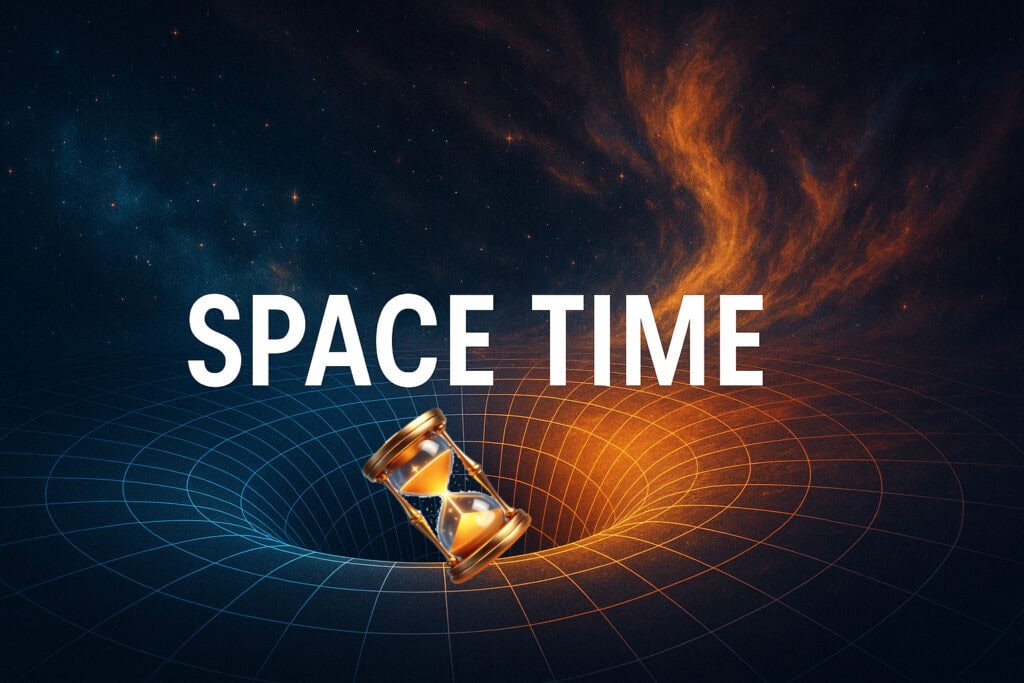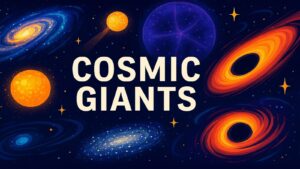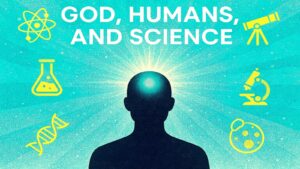Table of Contents
Introduction: Space Time—The Silent Sculptor of Reality
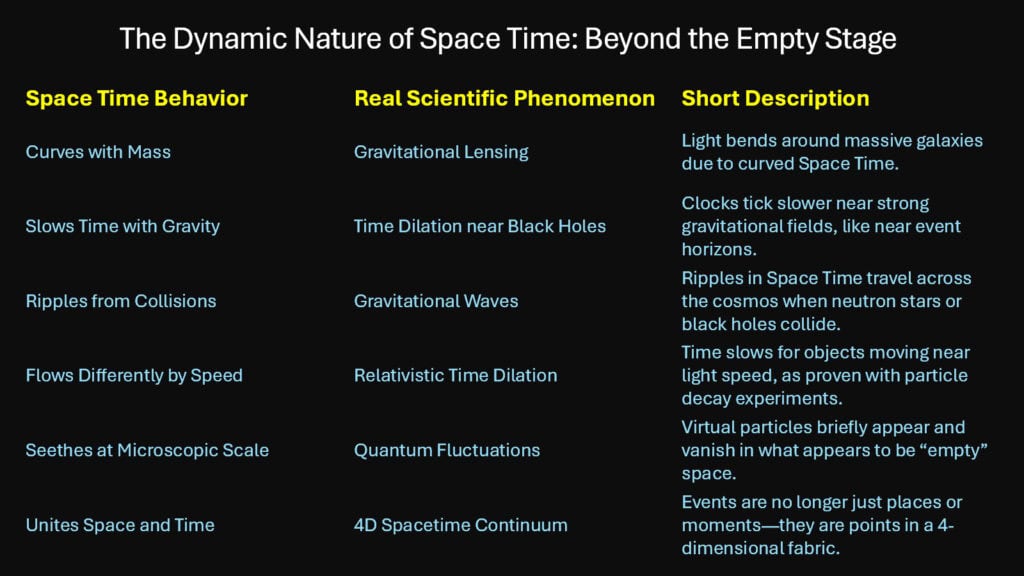
Space Time stands as one of the most powerful forces shaping our Universe. Far beyond simple distance and duration, it serves as the invisible architect of cosmic reality. This fundamental fabric bends light, guides gravity, and dictates how matter moves through the vast expanse of existence. Every galaxy, every star, every particle dances to its rhythm.
Most people think of space as empty void and time as a steady march forward. But Space Time reveals itself as something far stranger and more dynamic. It curves around massive objects like a stretched rubber sheet under weight. It flows differently for observers moving at various speeds through the cosmos. It can ripple with waves from distant collisions and bubble with quantum energy at microscopic scales.
Einstein’s revolutionary insights transformed our understanding of this cosmic stage. No longer passive, Space Time actively participates in every cosmic drama. It tells planets how to orbit stars. It determines why clocks tick slower near black holes. It carries the tremors of colliding neutron stars across billions of light-years.
The weirdness of Space Time challenges our everyday intuition. We experience it as stable and uniform, yet reality proves far more flexible. Each discovery reveals new layers of strangeness hiding beneath the surface of our cosmic home.
Table 1: Key Properties of Space Time
| Property | Classical View | Modern Understanding |
|---|---|---|
| Structure | Fixed stage for events | Dynamic, curved geometry |
| Time Flow | Universal constant | Relative to motion and gravity |
| Empty Space | Absolute vacuum | Quantum field fluctuations |
| Geometry | Flat Euclidean | Curved by mass-energy |
| Measurement | Same for all observers | Depends on reference frame |
1. Space Time Isn’t a Passive Stage—It’s a Shaping Force
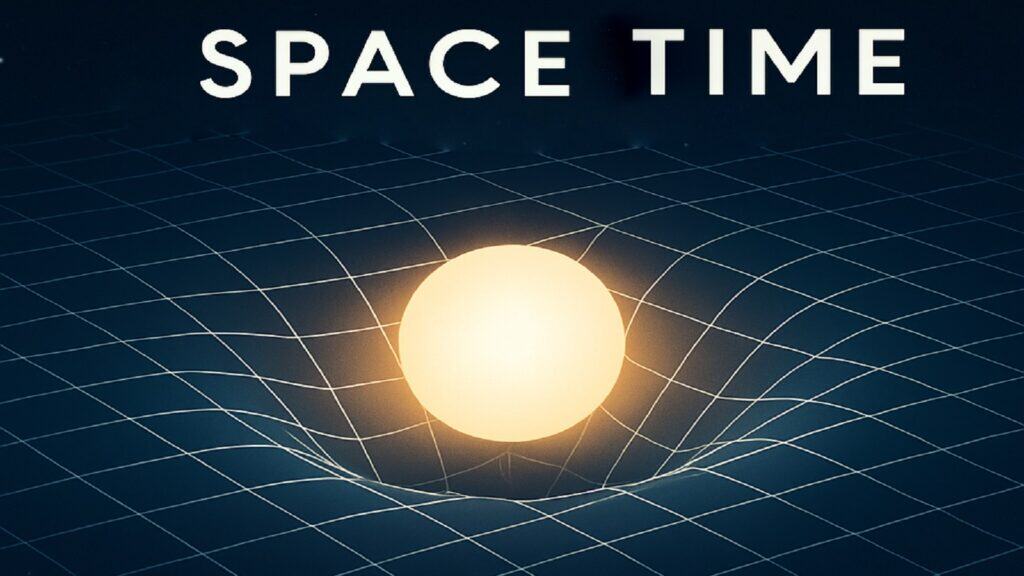
Space Time actively shapes the cosmic dance rather than merely hosting it. Einstein’s General Relativity revealed this profound truth through elegant mathematical language. Mass and energy warp the geometry of Space Time, creating curves that guide the motion of everything from photons to planets.
Picture a bowling ball placed on a stretched trampoline surface. The heavy ball creates a deep depression that causes marbles rolled nearby to curve toward it in graceful arcs. Similarly, massive objects like stars and planets bend Space Time around them through their gravitational influence. This curvature appears to us as gravitational attraction, but objects actually follow the straightest possible paths through curved geometry.
The Sun’s immense mass warps Space Time enough to bend light from distant stars passing near it. During total solar eclipses, astronomers observe stars appearing slightly displaced from their normal positions in the sky. This gravitational lensing effect provided early confirmation of Einstein’s radical ideas about the nature of space and time.
Mercury’s orbit demonstrates Space Time curvature in our own solar system. The planet’s elliptical path precesses slightly more than Newton’s gravity alone could explain. Einstein’s equations predicted this extra precession with remarkable precision, showing how Space Time geometry affects planetary motion.
Table 2: Evidence of Space Time Curvature
| Phenomenon | Observable Effect | Measured Value |
|---|---|---|
| Light Bending | Star displacement during eclipse | 1.75 arcseconds |
| Mercury Precession | Extra orbital advance per century | 43 arcseconds |
| Gravitational Redshift | Light frequency shift in gravity | Matches Einstein’s prediction |
| Time Dilation | GPS satellite clock adjustment | 38 microseconds per day |
| Frame Dragging | Gyroscope precession near Earth | 0.041 arcseconds per year |
2. Space Time Is Never the Same for Two Observers
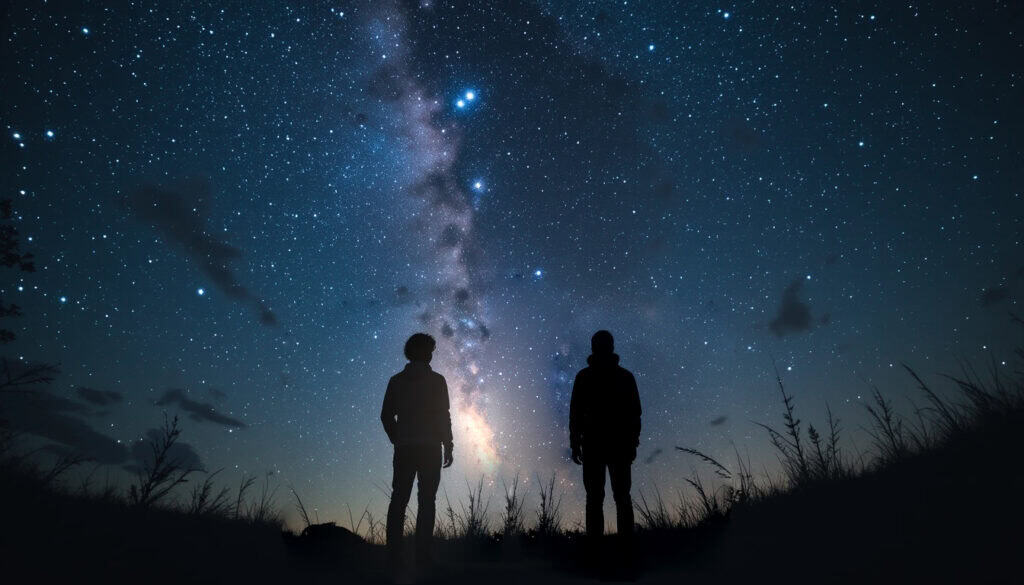
Time flows differently depending on your speed and location in a gravitational field. This relativistic effect means Space Time becomes deeply personal rather than universally shared. Two observers moving at different velocities will measure different durations for the same events.
A passenger on a high-speed train experiences time flowing slightly slower than someone standing stationary on the platform. The difference remains tiny at everyday speeds but becomes dramatically pronounced as velocities approach light speed. At 90 percent of light speed, time dilates by more than double compared to a stationary observer watching from afar.
Gravity also affects the flow of time through its influence on Space Time geometry. Clocks tick measurably slower in stronger gravitational fields than in weaker ones. A watch on Earth’s surface runs slower than an identical timepiece positioned high above the planet in orbit. This gravitational time dilation directly affects GPS satellites orbiting 20,000 kilometers above Earth’s surface.
Without correcting for relativistic effects, GPS navigation would accumulate errors of several kilometers per day. Satellite atomic clocks must be adjusted to account for both their orbital velocity and reduced gravitational field. These corrections demonstrate how Space Time relativity impacts modern technology.
Twin paradox scenarios illustrate the personal nature of Space Time. If one twin travels to a distant star at high speed while the other remains on Earth, the traveling twin returns younger. Time passes more slowly for the high-speed traveler, creating a real age difference between the siblings.
Table 3: Time Dilation Effects in Different Scenarios
| Scenario | Speed/Gravity Condition | Time Dilation Factor | Practical Impact |
|---|---|---|---|
| Commercial Jet | 900 km/h at 10 km altitude | 1.00000000005 | Nanosecond differences |
| GPS Satellites | 14,000 km/h orbital speed | 0.99999999956 | 38 microseconds daily |
| International Space Station | 27,600 km/h at 400 km | 0.99999999972 | Aging 0.01 seconds slower |
| Near Light Speed | 90% speed of light | 0.436 | Time passes half as fast |
| Black Hole Event Horizon | Extreme gravity | Approaches zero | Time nearly stops |
3. Space Time Can Ripple Like Water When Massive Events Strike
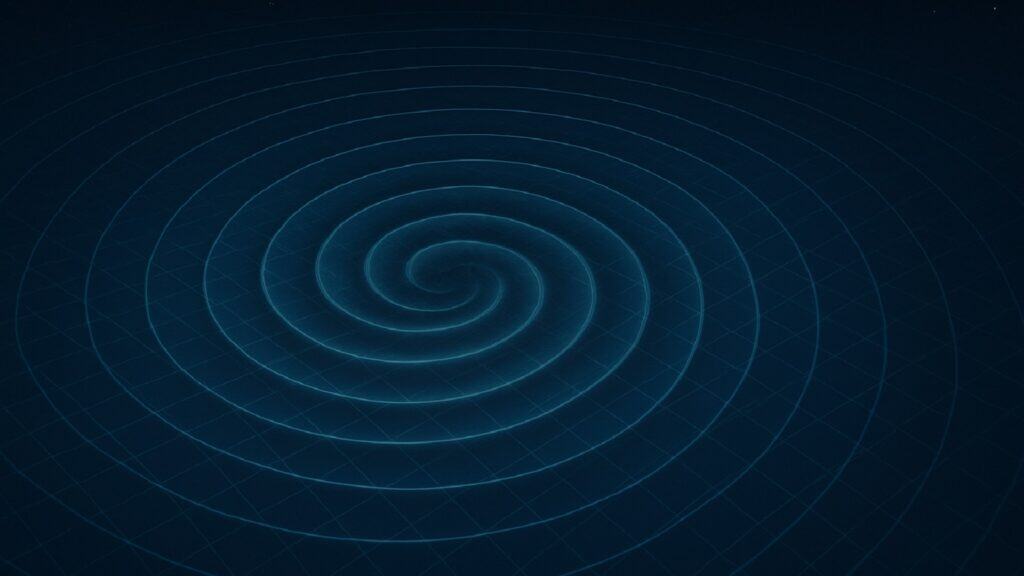
Gravitational waves signify fluctuations in the very structure of Space Time itself. These disturbances propagate outward from violent cosmic events at exactly the speed of light. When detected in 2015, they opened an entirely new window for observing the Universe.
The collision of two black holes creates the most powerful gravitational wave sources known in the Universe. As these massive objects spiral toward each other over millions of years, they accelerate to incredible speeds in their final dance. In their ultimate moments, they merge in a cataclysmic event that shakes Space Time across billions of light-years of cosmic distance.
LIGO detectors employ advanced laser interferometry techniques to detect these minute distortions in Space Time with unmatched accuracy. The instruments can detect changes smaller than one ten-thousandth the width of a proton particle. When gravitational waves pass through Earth, they alternately stretch and compress space by these minuscule amounts in perpendicular directions.
Neutron star collisions produce both gravitational waves and electromagnetic radiation. The detection of this phenomenon in August 2017 heralded the advent of multi-messenger astronomy. Scientists observed the same cosmic crash using both gravitational wave detectors and traditional telescopes.
These ripples carry information about their sources encoded in their frequency and amplitude. By analyzing gravitational wave patterns, astronomers can determine the masses of colliding objects and their distance from Earth. This technique provides new insights into black hole populations and neutron star properties.
Table 4: Major Gravitational Wave Detections
| Event | Date | Source Type | Distance (billion light-years) | Duration |
|---|---|---|---|---|
| GW150914 | September 2015 | Black hole merger | 1.3 | 0.2 seconds |
| GW170817 | August 2017 | Neutron star merger | 0.13 | 100 seconds |
| GW190521 | May 2019 | Intermediate black hole formation | 7.0 | 0.1 seconds |
| GW200115 | January 2020 | Black hole-neutron star merger | 0.9 | 3 seconds |
| GW190814 | August 2019 | Asymmetric mass merger | 0.8 | 2 seconds |
4. Space Time Is Not Empty—It Boils with Quantum Activity
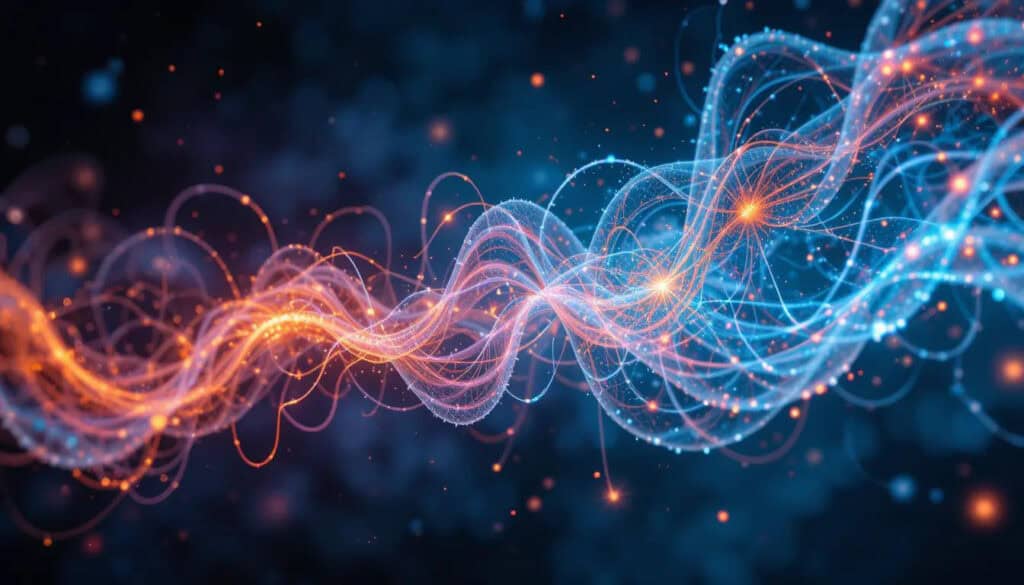
Empty space reveals itself as anything but vacant when examined at quantum scales throughout the Universe. The fabric of Space Time seethes with virtual particles that pop into existence and vanish in tiny fractions of a second. This quantum foam represents the fundamental graininess of reality at the smallest conceivable distances where our classical intuitions completely break down.
Heisenberg’s uncertainty principle permits the temporary borrowing of energy from the vacuum. These quantum fluctuations generate pairs of particles and antiparticles that swiftly annihilate one another, resulting in explosive energy bursts. This phenomenon occurs incessantly across the entirety of space, rendering the vacuum an active and dynamic medium teeming with perpetual activity.
The Casimir effect demonstrates the reality of quantum vacuum energy. Two parallel metal plates placed very close together experience an attractive force due to quantum fluctuations. The space between the plates contains fewer virtual particles than the surrounding vacuum, creating a pressure difference.
Zero-point energy represents the lowest possible energy state of quantum fields. Even at a temperature of absolute zero, quantum systems still possess this minimum energy as a result of the uncertainty principle. The total zero-point energy of the vacuum poses one of the greatest unsolved problems in physics.
Hawking radiation emerges from quantum effects near black hole event horizons. Virtual particle pairs at the black hole boundary sometimes separate permanently, with one particle falling in while the other escapes. This phenomenon leads to the gradual evaporation of black holes through the emission of radiation.
Table 5: Quantum Vacuum Phenomena
| Phenomenon | Scale/Energy | Observable Effect | Experimental Evidence |
|---|---|---|---|
| Virtual Particles | Planck time (10-43 seconds) | Vacuum polarization | Lamb shift in hydrogen |
| Casimir Force | Nanometer separation | Attractive force between plates | Measured in laboratory |
| Zero-Point Energy | All quantum fields | Lowest energy state | Theoretical prediction |
| Hawking Radiation | Black hole horizons | Black hole evaporation | Theoretical calculation |
| Vacuum Birefringence | Strong magnetic fields | Light polarization changes | Recently detected |
5. Space Time Might Be Made of Something Else Entirely
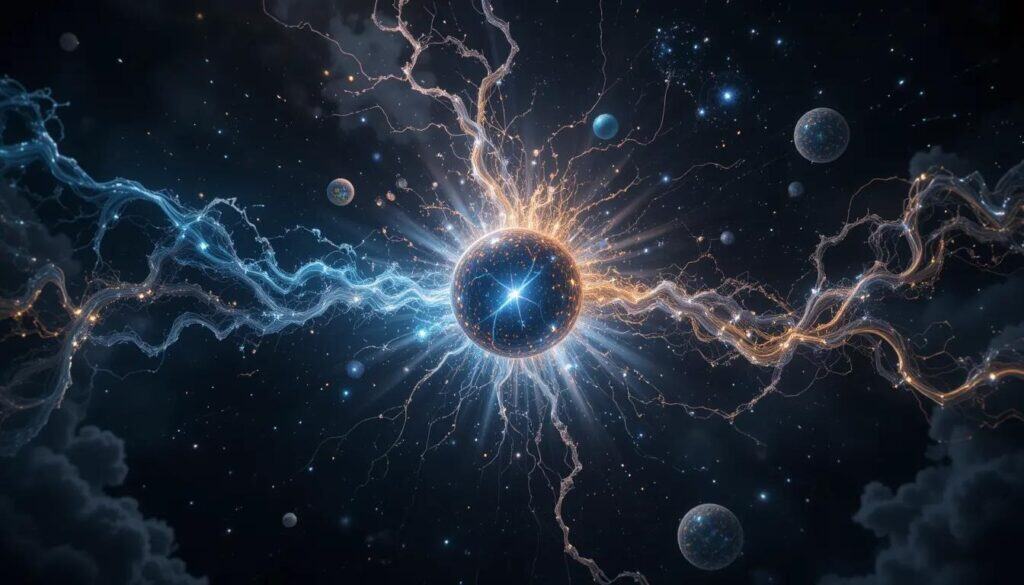
The smooth geometry of Space Time might be an illusion hiding a more fundamental granular structure beneath. Loop Quantum Gravity proposes that space and time themselves are quantized, built from discrete units rather than continuous fabric. This radical idea suggests reality has a pixelated nature at the smallest scales, like a digital photograph when viewed up close.
At the Planck length of 10-35 meters, the familiar concepts of distance and time may break down entirely. Below this incredibly tiny scale, quantum effects become so strong that Space Time itself fluctuates wildly like ocean waves in a storm. The smooth geometry we observe at larger scales emerges from this quantum foam like calm water viewed from a great distance.
String theory offers another perspective on Space Time’s fundamental nature.In this framework, the well-known three dimensions of space, along with one dimension of time, originate from vibrations occurring in higher-dimensional spaces. Extra dimensions remain hidden because they curl up into shapes too small to detect directly.
Emergent gravity theories propose that the force of gravitational attraction itself arises from more fundamental processes related to quantum information. Space Time and gravity might be collective behaviors of underlying quantum bits, similar to how temperature emerges from molecular motion without being fundamental.
These methodologies strive to harmonize General Relativity with quantum mechanics. While both theories function flawlessly within their individual realms, they conflict when considered together. To comprehend the true essence of Space Time, a unified theory of quantum gravity is essential.
Table 6: Theoretical Approaches to Quantum Space Time
| Theory | Key Concept | Space Time Structure | Testable Predictions |
|---|---|---|---|
| Loop Quantum Gravity | Quantized geometry | Discrete space-time loops | Big bounce instead of Big Bang |
| String Theory | Vibrating strings | Extra curled dimensions | Supersymmetric particles |
| Causal Set Theory | Discrete space-time points | Quantum causality network | Modified dispersion relations |
| Emergent Gravity | Information-based gravity | Holographic boundary | Dark matter modifications |
| Asymptotic Safety | Quantum field theory | Smooth at all scales | Modified black hole physics |
6. Space Time Can End—or Tear Apart at the Seams
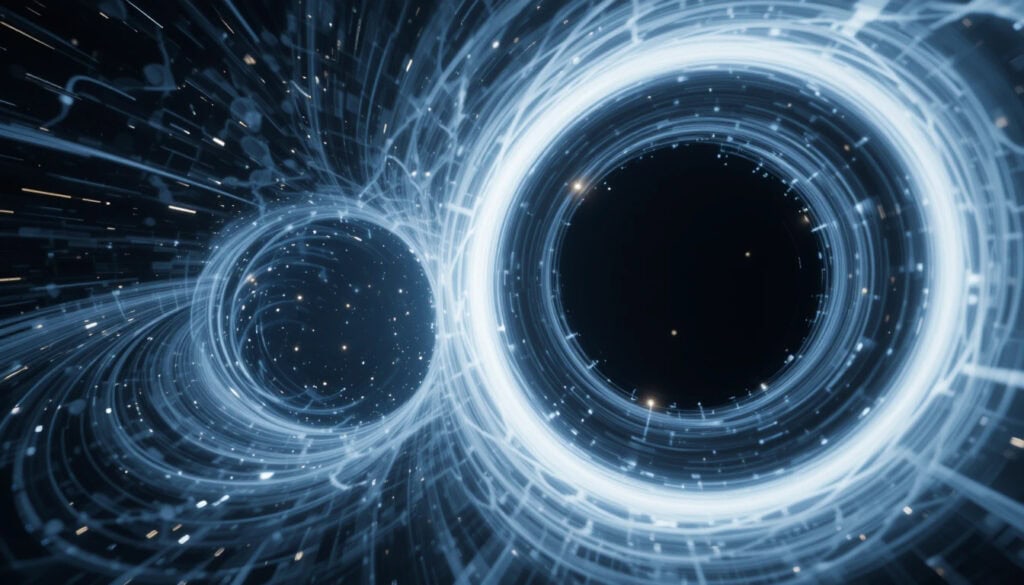
Singularities represent locations where Space Time itself breaks down completely. At these points, density becomes infinite and the curvature of Space Time reaches impossible values. Einstein’s equations simply stop working, revealing the limits of our current understanding.
Black hole centers contain gravitational singularities where matter collapses to infinite density. The event horizon hides these regions from outside observers, but nothing can prevent the inexorable compression once matter crosses this boundary. Time itself stops having meaning at the singularity.
The Big Bang likely began from a cosmological singularity where all matter and energy existed in a single point. Unlike black holes, this singularity expanded outward to create the entire observable Universe. The first moments after the Big Bang remain beyond our theoretical reach.
Some physicists propose that singularities might not actually exist in nature. Quantum effects could prevent infinite densities from forming, replacing singularities with exotic quantum states. Loop Quantum Gravity suggests black holes might bounce rather than collapse completely.
Cosmic strings and domain walls represent other ways Space Time could develop tears or defects. These theoretical objects would create discontinuities in the fabric of reality itself. While never observed, they remain possible relics from the early Universe’s phase transitions.
Table 7: Types of Space Time Breakdown
| Singularity Type | Location | Characteristics | Current Status |
|---|---|---|---|
| Gravitational | Black hole center | Infinite density/curvature | Hidden by event horizon |
| Cosmological | Big Bang origin | All matter in single point | Theoretical extrapolation |
| Naked | Hypothetical exposed | Visible infinite curvature | Forbidden by cosmic censorship |
| Ring | Rotating black hole | Donut-shaped singularity | Mathematical possibility |
| Timelike | Closed timelike curves | Causality violations | Probably impossible |
Conclusion: Space Time—The Unseen Author of All That Moves
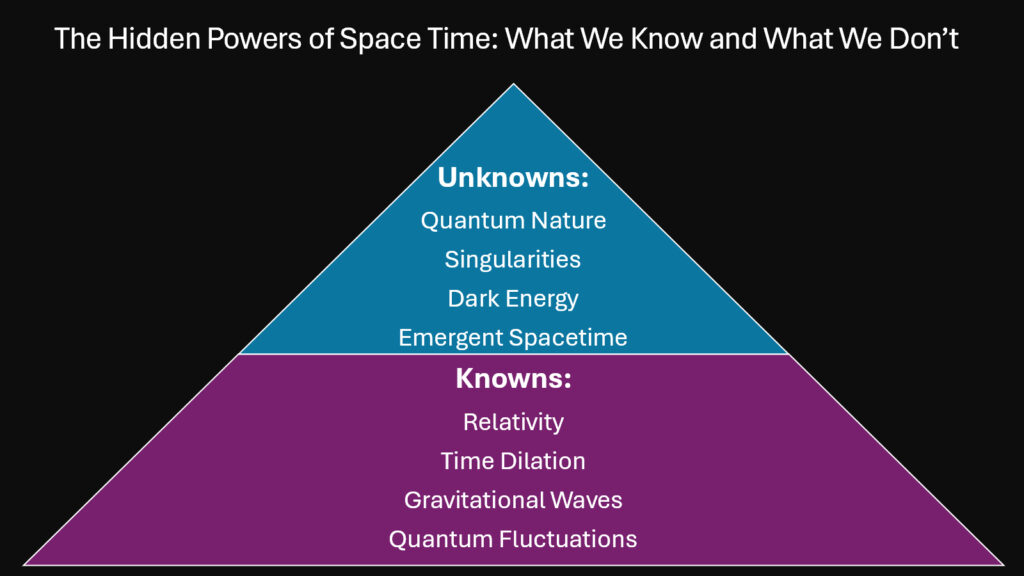
Space Time serves as the unseen conductor, orchestrating every cosmic symphony throughout the expansive Universe. It shapes the paths of planets around their stars, carries waves from distant collisions between massive objects, and bubbles with quantum energy at scales too small to imagine with our minds. Every motion, every interaction, every moment of existence unfolds within its curved embrace throughout all of cosmic history.
The journey through these weird truths reveals how little we truly understand about the stage on which we perform. Space Time remains simultaneously familiar and alien, supporting our daily lives while hiding profound mysteries. Its relativity challenges our intuitions. Its quantum nature defies easy visualization.
Modern physics has pulled back the curtain to reveal space-time as an active participant rather than a passive backdrop. It bends around matter, flows differently for each observer, and ripples with gravitational waves. At quantum scales, it seethes with virtual particles and might even be built from discrete pieces.
Yet for all our discoveries, Space Time keeps its deepest secrets. We don’t know if it truly breaks down at singularities or emerges from something more fundamental. We can’t reconcile its smooth classical behavior with quantum mechanics’ grainy reality. The nature of dark energy stretching Space Time remains mysterious.
Perhaps the strangest truth is that we exist within this cosmic architecture as both observers and participants. Our measurements shape what we can know about Space Time’s properties. Our presence as conscious beings represents one of the Universe’s most remarkable achievements.
Table 8: Frontiers in Space Time Research
| Research Area | Current Challenge | Potential Breakthrough | Timeline |
|---|---|---|---|
| Quantum Gravity | Unifying relativity and quantum mechanics | Theory of everything | Decades to centuries |
| Dark Energy | Understanding cosmic acceleration | Modified gravity theories | Next 10-20 years |
| Black Hole Interior | What happens at singularities | Quantum gravity effects | Theoretical progress ongoing |
| Gravitational Waves | Detecting primordial signals | Early Universe observations | Next 5-10 years |
| Extra Dimensions | Finding hidden spatial dimensions | Large Hadron Collider results | Ongoing experiments |
In this strange and wonderful cosmic home, we remain travelers navigating the curves and flows of Space Time itself. Each new discovery reveals another layer of weirdness hiding beneath reality’s surface. The journey continues as it is carried by the very fabric we seek to understand.

